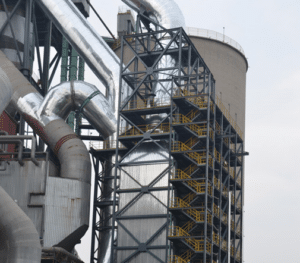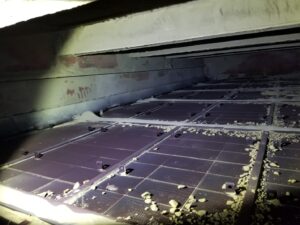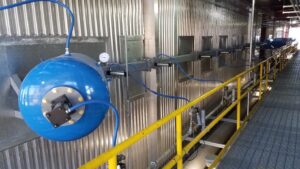Newsroom - Jul 26, 2023
Breaking Ground: SCRs Pave the Way for a Sustainable Cement Industry
NOx in Cement Plants
Nitrogen oxides (NOx) are harmful air pollutants that can have significant negative impacts on human health and the environment. NOx is formed during high-temperature combustion processes, such as those used in cement kilns, and contributes to the formation of ground-level ozone, which is a major component of smog.
Exposure to high levels of NOx can cause a range of health problems, including respiratory issues, cardiovascular disease, and lung cancer. NOx can also contribute to the formation of acid rain, which can damage ecosystems and harm aquatic life.
In addition to the health and environmental benefits, reducing NOx emissions from cement production is also becoming increasingly important from a regulatory perspective. Many countries have introduced stricter emissions standards for NOx, and failing to comply with these standards can result in significant fines and penalties for cement manufacturers.
Most recently, the Good Neighbor Provision has set specific goals and targets for cement plants in 23 states in the US: Alabama, Arkansas, California, Illinois, Indiana, Kentucky, Louisiana, Maryland, Michigan, Minnesota, Mississippi, Missouri, Nevada, New Jersey, New York, Ohio, Oklahoma, Pennsylvania, Texas, Utah, Virginia, West Virginia, and Wisconsin.
The Good Neighbor Provision
The “Good Neighbor Provision” refers to a provision in the Clean Air Act (CAA) of the United States that requires states to address air pollution that crosses state boundaries and affects neighboring states. The GNP aims to reduce NOx emissions from power plants and industrial facilities from upwind states that significantly hinder downwind states from attaining and maintaining the 2015 Ozone NAAQS. The provision applies to emissions of nitrogen oxides (NOx) and sulfur dioxide (SO2), which are pollutants that can contribute to the formation of ozone and fine particulate matter.
Under the Good Neighbor Provision, each state is required to develop a State Implementation Plan (SIP) that includes measures to prevent significant contributions to air pollution in neighboring states. If a state fails to develop an adequate SIP or fails to comply with the requirements of the SIP, the Environmental Protection Agency (EPA) can issue a Federal Implementation Plan (FIP) to address air pollution.
The Good Neighbor Provision has been instrumental in reducing the amount of air pollution that crosses state boundaries and contributes to poor air quality in neighboring states. It has also led to the development of new technologies and strategies for reducing emissions of NOx and SO2 from industrial sources, such as power plants and factories.
How Does GNP Affect Cement Companies?
In the context of the cement industry, the Good Neighbor Provision has an impact on all plants and companies within the specified states of the provision. These companies must implement measures to reduce emissions of pollutants, such as particulate matter, nitrogen oxides, and sulfur dioxide, that could affect air quality in neighboring states.
The implementation of the Good Neighbor Provision will increase the cost of production for cement companies and bring new operational challenges, as they will likely need to invest in new NOx control equipment and technologies to reduce emissions. Overall, the Good Neighbor Provision could have a significant impact on the cement industry by requiring companies to improve their environmental performance and reduce their impact on neighboring communities.
The following are NOx limit changes in Cement and Concrete Product Manufacturing:
- Form of Final Emission Limit: Pounds per ton of clinker
- Long Wet: 4.0 lb/ton
- Long Dry: 3.0 lb/ton
- Preheater: 3.8 lb/ton
- Precalciner: 2.3 lb/ton
- Preheater/Precalciner: 2.8 lb/ton
SCR in Cement Industry
The Benefits of Using SCR to Reduce NOx Emissions in Cement Production
- Most effective NOx reduction equipment. SCR technology can achieve up to 99% removal. In many cases, the installation of an SCR will be the only effective way to reach the compliance limits.
- Can be retrofitted to existing plants: SCR systems can be retrofitted to existing cement plants, making it a cost-effective way to reduce NOx
- Plants can achieve up to 95% cleaning efficiency of their SCRs with help from a trusted expert in the field of SCR performance enhancement.
SCR systems require careful monitoring and maintenance to ensure optimal performance, maintain good flue gas flow and ammonia mixing, and keep the catalyst surface area free from buildup. The reductant injection rate and temperature must be carefully controlled to achieve maximum NOx reduction efficiency.
Working with an experienced SCR OEM and SCR cleaning company is critical to properly design the system. SCRs can be very effective in high dust applications, however poor design and inadequate online cleaning can be catastrophic.
By implementing the proper methods, cement manufacturers can significantly reduce NOx emissions and contribute to a cleaner and healthier environment.
How to Maintain the SCR?
Air cannons can be used in SCR systems to help maintain optimal performance by preventing the build-up of ash and other particles on the catalyst surface. The air cannons are installed to clean the catalyst by re-entraining and redistributing ash to let the flue gas pass through.
The following are some benefits of using air cannons in SCR systems:
- Eliminates excessive pressure drop and maintains designed NOx removal rates.
- Improves system efficiency: A clean catalyst surface allows for optimal contact between the flue gas and the catalyst, resulting in higher NOx reduction efficiency.
- Low operating costs: Air cannons are relatively low-cost and require minimal maintenance.
- Easy to install: Air cannons can be easily installed in existing SCR systems with minimal disruption to the operation of the plant.
It is important to note that the air cannons must be maintained and operated efficiently. Improper use and failure to preserve the integrity of the cannons can render them ineffective and lead to excessive levels of buildup over time. Therefore, regular monitoring and adjustment of the air cannon settings are necessary to ensure optimal performance of the SCR system.
In addition, proper SCR maintenance means coupling the cannons with state-of-the-art CatFlow screens to ensure peak operational levels are maintained. The CatFlow screen captures the ash on its surface while the air cannon system sweeps it away, thus providing the best possible cleaning techniques to keep the SCR running at full capacity.
How to Select the Right Air Cannon for Your SCR?
It is important to consider several factors when selecting air cannons for an SCR system, including the specific requirements of the system, the characteristics of the dust or particulate matter being produced, and the operating conditions of the plant.
Each brand or product may have its unique advantages and disadvantages, and it is important to focus on companies that have extensive experience with various applications. Plants can achieve up to 95% cleaning efficiency of their SCRs by leaning on this experience and partnering with an expert in the field of SCR optimization.
Case Study: IGS Air Cannons installed in a cement plant in the United States
As the cement industry faced mounting pressure to reduce emissions, a US cement plant proactively anticipated the implementation of Selective Catalytic Reduction (SCR) technology. Recognizing the importance of SCR systems, this plant conducted a trial by installing SCRs in Europe and at their plant in the US. This case study focuses on the challenges faced during the trial, the implementation of an innovative solution, and the subsequent success achieved by integrating IGS CatFlow™ Screens and an air cannon cleaning system.
Trial Challenges:
During the initial phase of the trial, the cement plant encountered a significant hurdle in the form of extreme buildup on the SCR catalyst. This accumulation and pressure drop of the system severely limited the effectiveness of the SCR system, hindering its production capacity as well as its ability to reduce emissions. The buildup threatened to undermine the efficacy of the entire project, highlighting the urgent need for a solution to address this challenge.
Above: IGS CatFlow screens and air cannon nozzles combine to re-entrain and redistribute ash evenly throughout the catalyst.
Innovative Solution: CatFlow™ Screens and Air Cannon Cleaning System:
To overcome the catalyst buildup issue, IGS offered a comprehensive SCR online cleaning system, including air cannons and CatFlow screens. The screens were strategically installed on the catalyst to prevent ash and other deposits from accumulating on the surface. These screens allowed the catalyst to function optimally while keeping it free from excessive buildup. Additionally, an air cannon cleaning system was implemented to re-entrain and redistribute ash to allow the flue gas to naturally pull the ash through the system.
IGS Big Blue Air Cannon System
Successful Implementation and Results:
The integration of the CatFlow™ Screens and air cannon cleaning system proved to be a game-changer for this cement plant. The innovative solution effectively resolved the catalyst buildup issue, enabling the SCR system to reduce emissions while allowing the plant to return to full capacity. The screens prevented excessive accumulation, allowing the catalyst to operate at its peak efficiency. As a result, the plant witnessed a significant improvement in the performance of the SCR system.
Conclusion:
This case study exemplifies the proactive approach taken by the cement industry to address environmental concerns through the adoption of SCR technology. The successful integration of CatFlow™ Screens and an air cannon cleaning system provided a robust solution to the challenge of catalyst buildup. This cement plant’s positive experience showcases the importance of innovative solutions in optimizing SCR performance, reducing emissions, and meeting regulatory requirements.




